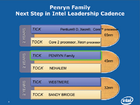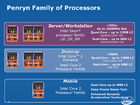Monday, August 6th 2007

Intel Sheds Light on Penryn Enhancements
With Intel's Penryn set to launch next quarter, Intel has decided to shed some light on improvements it has made to the architecture, and prove that Penryn is not just a shrunk Conroe.
Intel has decided to improve existing Wide Dynamic Execution, Advanced Smart Cache, Advanced Digital Media Boost and Intelligent Power Capability, technologies that previously made their debut with Conroe and Merom.
Below is Intel's Tick-Tock long term roadmap, as well as "Penryn" plans (source: HKEPC)Penryn enhances Wide Dynamic Execution technology with a fast radix-16 divider and improved Virtualization technology, which should boost divide instruction capability and reduce virtual machine transition latencies by 25-to-75%.
Advanced Smart Cache not only increases the cache size (6MB and 12MB L2-cache on dual and quad-core CPUs, respectively), but also reduces its latency.
Advanced Digital Media Boost technology is the inclusion of a new Intel SSE4 instruction set. SSE4 introduces 47 new instructions to improve performance of video accelerators, graphics building blocks and streaming load. Intel claims a 2x performance gain in video acceleration tasks. There are 14 new instructions for video accelerator performance enhancement. Intel improves compiler auto-vectorization performance with 32 new instructions.
Intel expects SSE4 optimizations to deliver performance improvements in video authoring, imagine, graphics, video search, off-chip accelerators, gaming and physics applications.
Mobile Penryn processors receive enhanced power saving technologies. New to the mobile Penryn is a deep power down state. In the deep power down state, the processor lowers the core voltage, more so than in the C4 state, and turns off the L1 and L2 caches. Intel claims significant power savings in idle modes for extended battery life with the new power state.
Source:
DailyTech
Intel has decided to improve existing Wide Dynamic Execution, Advanced Smart Cache, Advanced Digital Media Boost and Intelligent Power Capability, technologies that previously made their debut with Conroe and Merom.
Below is Intel's Tick-Tock long term roadmap, as well as "Penryn" plans (source: HKEPC)Penryn enhances Wide Dynamic Execution technology with a fast radix-16 divider and improved Virtualization technology, which should boost divide instruction capability and reduce virtual machine transition latencies by 25-to-75%.
Advanced Smart Cache not only increases the cache size (6MB and 12MB L2-cache on dual and quad-core CPUs, respectively), but also reduces its latency.
Advanced Digital Media Boost technology is the inclusion of a new Intel SSE4 instruction set. SSE4 introduces 47 new instructions to improve performance of video accelerators, graphics building blocks and streaming load. Intel claims a 2x performance gain in video acceleration tasks. There are 14 new instructions for video accelerator performance enhancement. Intel improves compiler auto-vectorization performance with 32 new instructions.
Intel expects SSE4 optimizations to deliver performance improvements in video authoring, imagine, graphics, video search, off-chip accelerators, gaming and physics applications.
Mobile Penryn processors receive enhanced power saving technologies. New to the mobile Penryn is a deep power down state. In the deep power down state, the processor lowers the core voltage, more so than in the C4 state, and turns off the L1 and L2 caches. Intel claims significant power savings in idle modes for extended battery life with the new power state.


53 Comments on Intel Sheds Light on Penryn Enhancements
But it sounds good :p. lol
Someone on that bbs actually poses an interesting question -- could the next release of MacOS X have been delayed so that it could roll out simultaneously with the new Intel chips?
I want to know how it works, not some flashy buzzwords that took all night for a group of £500 an hour dossers to synthesise. Must I wait for Ars Technica to sift through the crap and actually say how it works every time?
By the power of greyskull!
PS: is it the same Nahelem that was spoke of in this article from 2003? : www.theinquirer.net/?article=7481 (10.20GHz lmfao)
Wow 4ghz+ stock dual core and it beats current core 2's by a bit to. That's just great for amd....
AMD will be fine, their procs will be fine. these should float AMD with Intel if not spar well with Intel. Subtle changes on Intels front and nice improvements, but they really need to go with the on die memory controller, like theyve talked about.
I like them both , I buy what's best. It is not looking good for competition:shadedshu